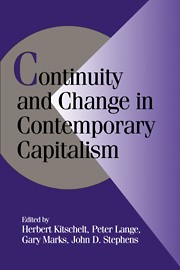Book contents
- Frontmatter
- Contents
- List of Contributors
- Preface
- Introduction
- PART I THE INTERNATIONAL SETTING FOR POLITICAL-ECONOMIC STRATEGIES
- PART II THE DYNAMICS OF DOMESTIC POLITICAL ECONOMIES
- 4 Divergent Production Regimes: Coordinated and Uncoordinated Market Economies in the 1980s and 1990s
- 5 The Political Economy of Europe in an Era of Interdependence
- 6 The Welfare State in Hard Times
- 7 Postwar Trade-Union Organization and Industrial Relations in Twelve Countries
- 8 Social Democratic Labor Market Institutions: A Retrospective Analysis
- 9 The Declining Significance of Male Workers: Trade-Union Responses to Changing Labor Markets
- PART III POLITICAL ECONOMY AND DEMOCRATIC COMPETITION
- PART IV CONCLUSION
- References
- Index
- Title in the series
4 - Divergent Production Regimes: Coordinated and Uncoordinated Market Economies in the 1980s and 1990s
Published online by Cambridge University Press: 05 June 2012
- Frontmatter
- Contents
- List of Contributors
- Preface
- Introduction
- PART I THE INTERNATIONAL SETTING FOR POLITICAL-ECONOMIC STRATEGIES
- PART II THE DYNAMICS OF DOMESTIC POLITICAL ECONOMIES
- 4 Divergent Production Regimes: Coordinated and Uncoordinated Market Economies in the 1980s and 1990s
- 5 The Political Economy of Europe in an Era of Interdependence
- 6 The Welfare State in Hard Times
- 7 Postwar Trade-Union Organization and Industrial Relations in Twelve Countries
- 8 Social Democratic Labor Market Institutions: A Retrospective Analysis
- 9 The Declining Significance of Male Workers: Trade-Union Responses to Changing Labor Markets
- PART III POLITICAL ECONOMY AND DEMOCRATIC COMPETITION
- PART IV CONCLUSION
- References
- Index
- Title in the series
Summary
The systematic analysis of advanced capitalist economies has had two main focuses. One has been the welfare state: this owes much to the work of Esping-Andersen in distinguishing three welfare state patterns in advanced economies (Esping-Andersen, this volume; Stephens, Huber, and Ray this volume). His distinctions have been widely accepted. There is less agreement in the analysis of the other main focus – and the focus of this chapter – production regimes; Hall (this volume) relates the discussion in this chapter to other approaches, notably of Sabel and of Hollingsworth and Streeck. The concluding section of this book sketches links between the classification of production regimes advanced here and that of welfare states (Kitschelt, Marks, and Stephens, this volume).
By a production regime is meant the organization of production through markets and market-related institutions. It analyzes the ways in which the microagents of capitalist systems – companies, customers, employees, owners of capital – organize and structure their interrelationships, within a framework of incentives and constraints or “rules of the game” set by a range of market-related institutions within which the microagents are embedded. These framework incentives and constraints are sometimes summarized as the “institutional framework” of the production side of the economy. The most important of the institutions contributing to the institutional framework are the financial system, the industrial relations system, the education and training system, and the intercompany system (the latter governing relations between companies – competition policy, technology transfer, standard setting, and so on).
- Type
- Chapter
- Information
- Continuity and Change in Contemporary Capitalism , pp. 101 - 134Publisher: Cambridge University PressPrint publication year: 1999
- 297
- Cited by



